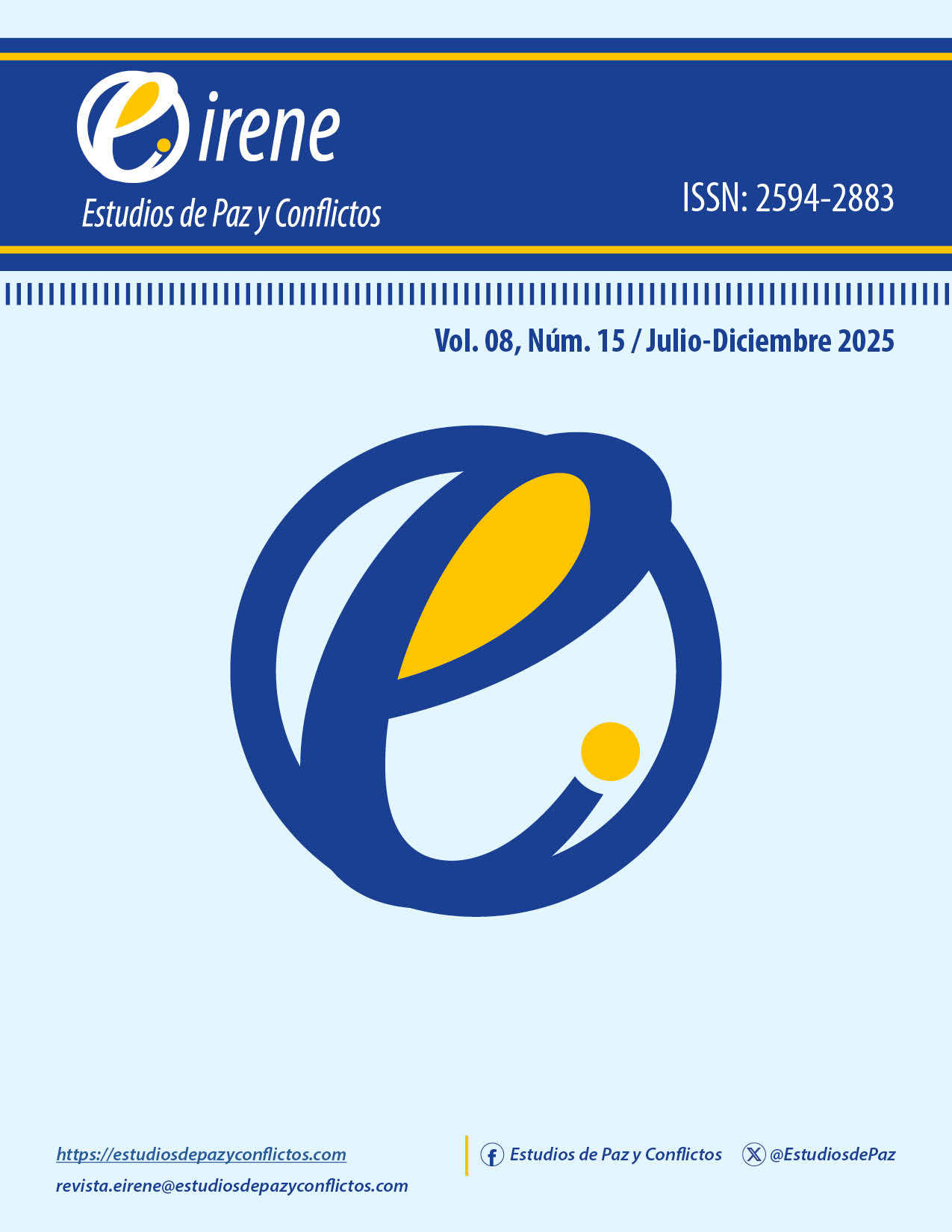The importance of gender perspective and emotions in mediation practice
DOI:
https://doi.org/10.62155/eirene.v8i15.328Keywords:
Mediation, Gender perspective, emotionsAbstract
The purpose of this paper is to highlight the importance of the gender perspective and emotions in the mediation process, with the understanding that mediation is a process that contributes to peacebuilding and, therefore, mediators who apply the gender perspective and consider the relevance of emotions in this process more fully fulfill their role as peace agents.
The central purpose of mediation is to help the parties involved transform or resolve conflicts. Conflict is an incompatibility of cognitions or emotions between individuals or groups of individuals; the cause of conflict is the perception or belief that there are opposing needs, desires, ideas, interests, and objectives. This leads to the adoption of positions regarding the conflict and the emergence of emotions, which are often conflicting. It is essential that the mediator allows each person involved in the conflict to view these emotions from a gender perspective and enable them to change their narrative regarding their needs. This is why the circular narrative model is so important.
Downloads
References
Aase M. et. al. (2011). Sabona. En busca de buenas soluciones. Aprendiendo a Resolver conflictos, México: Montiel y Soriano editores
Bisquerra A. R. (2000). Educación emocional y bienestar, Barcelona, España: Praxis.
Cobb, S. (2016). Hablando de violencia: la política y las poéticas narrativas en la resolución de conflictos, Barcelona: Gedisa.
Comins I. (2003). Del miedo a la diversidad a la ética del cuidado: una perspectiva de género. Convergencia Revista de Ciencias Sociales, 10 (33), 97-122.
Congreso de la Unión. (2007, febrero 1). Ley General de Acceso de las Mujeres a una Vida Libre de Violencia. Diario Oficial de la Federación.
Espinar-Ruiz, E., & Mateo-Perez, M. A. (2007). “Violencia de género: reflexiones conceptuales, derivaciones prácticas”, en Papers Revista de Sociología, Barcelona: Universidad Autónoma de Barcelona, 86: 189–201. DOI: https://doi.org/10.5565/rev/papers/v86n0.817
Galtung, J., Lynch, J. y Mc.Goldrik, A. (2006). Reporteando conflictos. Una introducción al periodismo de la paz, México: Montiel y Soriano Editores.
Goleman, D. (1998). La inteligencia emocional en la práctica, Barcelona, España: Editorial Kairós.
Inmujeres (2007) .Glosario de términos, México: Instituto Nacional de las Mujeres. Disponible en: https://campusgenero.inmujeres.gob.mx/glosario/terminos/estereotipos-de-genero
Jarés, X, R. (2001). Educación y conflicto. Guía de educación para la convivencia, Madrid: Editorial Popular.
Lagarde, M. (2005), Los cautiverios de las mujeres: madresposas, monjas, putas, presas y locas, México: Universidad Nacional Autónoma de México.
Lamas, M. (2000). “Diferencias de sexo, género y diferencia sexual” en Cuicuilco 7(18): 1–24, México: Escuela Nacional de Antropología e Historia. Disponible en: https://www.redalyc.org/pdf/351/35101807.pdf
Lamas, M. (2003). “Usos, dificultades y posibilidades de la categoría género” en Lamas Marta et al. [comps.], El Género la construcción cultural de la diferencia sexual, México: PUEG – Miguel Ángel Porrúa, pp. 327-366
Lamas, M. (2025). ¿Ideología de género? Disputas políticas sobre la diferencia sexual, Madrid: Taurus.
Lerner, G. (1985). La creación del patriarcado. Primera. ed.. Madison, Wisconsin: Editorial Crítica. Disponible en: repositorio.ciem.ucr.ac.cr/bitstream/123456789/126/1/RCIEM109.pdf (el 3 de enero de 2019).
López M. M. (dir) (2004). Enciclopedia de Paz y Conflictos, España: Universidad de Granada.
Martínez G. V. (2001). Filosofía para hacer las paces, Barcelona, España: Icaria.
Martínez G. V. (2003). Culturas para hacer las paces y educar con cuidado en Actas del I Congreso Hispanoamericano de Educación y Cultura de Paz: Universidad de Granada.
Muciño, W. (2016). Las mujeres violentadas y sus formas de resolver los conflictos. (Tesis de Maestría en Medios de Solución de conflictos), México: Centro Universitario de Ixtlahuaca.
ONU (2012). Directrices de las Naciones Unidas para una mediación eficaz. Disponible en: http://peacemaker.un.org/sites/peacemaker.un.org/files/GuidanceEffectiveMediation_UNDPA2012%28spanish%29_1.pdf.
Sallard L. S. (2009). Mediación, supervisión y contensión. Una visión tridemensional. Sonora: Unison.
Serret, E. (2008). Qué es y para qué es la perspectiva de género, Oaxaca: Instituto de la Mujer Oaxaqueña del Gobierno Constitucional del Estado de Oaxaca.
Suares, M. (1996). Mediación: conducción de disputas, comunicación y técnicas, Barcelona, Paidós.
Downloads
Published
How to Cite
Issue
Section
ARK
License
Copyright (c) 2025 Guillermina Díaz Pérez, Natalia Ix-Chel Vázquez González

This work is licensed under a Creative Commons Attribution-NonCommercial 4.0 International License.
Copyright Notices Proposed by Creative Commons
1. Proposed Policy for Journals Offering Open Access
Those authors who have publications with this journal, accept the following terms:
a. Authors will retain their copyright and guarantee the journal the right of first publication of their work, which will be simultaneously subject to the Creative Commons Recognition License for which the user is free to: share, copy and redistribute the material in any medium or format; and to remix, transform and build from the material. This under the following terms:
- Credit must be given appropriately (journal, author, url / doi).
- A link to the license is provided.
- It is indicated if the changes were made.
- They are not used for commercial purposes.
b. Authors may adopt other non-exclusive license agreements for the distribution of the published version of the work (eg: deposit it in an institutional telematic archive or publish it in a monographic volume) provided that the initial publication in this journal is indicated.
c. Authors are allowed and recommended to disseminate their work through the Internet (eg: in institutional telematic files or on their website) before and during the submission process, which can lead to interesting exchanges and increase citations of the published work. (See The effect of open access).






.png)



.png)
.jpg)






